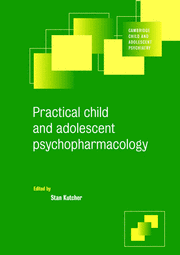Crossref Citations
This Book has been
cited by the following publications. This list is generated based on data provided by Crossref.
Steiner, Hans
Saxena, Kirti
and
Chang, Kiki
2003.
Psychopharmacologic Strategies for the Treatment of Aggression in Juveniles.
CNS Spectrums,
Vol. 8,
Issue. 4,
p.
298.
Mehler-Wex, C.
Wewetzer, Ch.
and
Gerlach, M.
2004.
Neuro-Psychopharmaka im Kindes- und Jugendalter.
p.
151.
Mehler-Wex, C.
and
Warnke, A.
2004.
Neuro-Psychopharmaka im Kindes- und Jugendalter.
p.
297.
van den Ban, Els
2004.
Twee keer is scheepsrecht.
Kind & Adolescent Praktijk,
Vol. 3,
Issue. 4,
p.
15.
Seifert, J.
2004.
Neuro-Psychopharmaka im Kindes- und Jugendalter.
p.
209.
Welniarz, Bertrand
2004.
Le traitement de l'hyperactivité : autour de la prescription de psychostimulants.
Perspectives Psy,
Vol. 43,
Issue. 1,
p.
65.
2004.
Selected Abstracts from the 23rd Annual Meeting of the Canadian Academy of Child and Adolescent Psychiatry, November 2?4, 2003, Halifax, Nova Scotia.
Child and Adolescent Psychopharmacology News,
Vol. 9,
Issue. 1,
p.
10.
Kowalik, S.C.
2005.
A Comparison of Recently Published Child and Adolescent Psychopharmacology BooksPractical Child and Adolescent Psychopharmacology. By Stan Kutcher , editor. Cambridge University Press, Cambridge, UK, 2002; 454 pages. $60.00 (softcover).Child And Adolescent Clinical Psychopharmacology, Third Edition. By Wayne Hugo Green , M.D. 2001; Lippincott Williams & Wilkins, Philadelphia (Pennsylvania), 347 pages. $49.95.Pharmacotherapy for Child and Adolescent Psychiatric Disorders, 2nd Edition. By D.R. Rosenberg , P.A. Davanzo , and Samuel Gershon . 2002, Marcel Dekker, Inc., New York, 745 pages. $199.95.Pediatric Psychopharmacology: Principles and Practice. Edited by Andres Martin , M.D., M.P.H., Lawrence Scahill , Ph.D., Dennis S. Charney , M.D., and James F. Leckman M.D., editors. Oxford University Press, New York, 2003; 791 pages. $129.95 (hardcover).Clinical Handbook of Psychotropic Drugs for Children and Adolescents. By Kalyna Z. Bezchlibnyk-Butler and Adil S. Virani , editors. Hogrefe & Huber Publishers, Cambridge, Mass., 2004: 306 pages. $49.95 (spiral bound paperback).
Journal of Child and Adolescent Psychopharmacology,
Vol. 15,
Issue. 1,
p.
127.
Hirsch, Amanda J.
and
Carlson, John S.
2007.
Prescription Practices and Empirical Efficacy of Psychopharmacologic Treatments for Pediatric Major Depressive Disorder.
Journal of Child and Adolescent Psychiatric Nursing,
Vol. 20,
Issue. 4,
p.
222.
James, Anthony
and
McClellan, Jon
2008.
Cambridge Textbook of Effective Treatments in Psychiatry.
p.
819.
Klampfl, K.
Warnke, A.
and
Seifert, J.
2009.
Neuro-Psychopharmaka im Kindes- und Jugendalter.
p.
353.
Mehler-Wex, C.
Wewetzer, Ch.
and
Gerlach, M.
2009.
Neuro-Psychopharmaka im Kindes- und Jugendalter.
p.
255.
Welniarz, Bertrand
and
Lauth, Bertrand
2011.
Le traitement de l’hyperactivité.
Perspectives Psy,
Vol. 50,
Issue. 1,
p.
78.
Huynh, Presenters: Nga T.
Gathright, Molly M.
Holmes, Khiela J.
and
Coffey, Discussant: Barbara
2013.
Worsening Psychosis after Fever of Unknown Origin in an Adolescent Boy with Autism.
Journal of Child and Adolescent Psychopharmacology,
Vol. 23,
Issue. 3,
p.
224.
Warnke, Andreas
2014.
Psychiatric Drugs in Children and Adolescents.
p.
359.
2017.
Essential Clinical Guide to Understanding and Treating Autism.
p.
245.
2021.
A Practical Guide to Autism.
p.
225.





